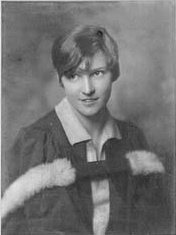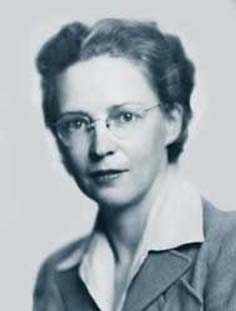Elsie MacGill
|
|
Elizabeth Muriel Gregory "Elsie" MacGill (March 27, 1905 – November 4, 1980), made famous as the Queen of the Hurricanes, was a aeronautical engineer during World War II who did much to make Canada a powerhouse of airplane construction during her years at Canada Car and Foundry in Fort William, Ontario. After her work at CC&F she ran a successful consulting business, and became famous again in 1970 as the co-author of the Royal Commission Report on the Status of Women.
Elsie was born in Vancouver on March 27, 1905, daughter of James Henry MacGill, a prominent Vancouver lawyer, and Helen Gregory MacGill, British Columbia's first woman judge. Her mother was an advocate of women's suffrage and influenced Elsie's decision to study engineering. She became the first Canadian woman to graduate with a degree in electrical engineering from the University of Toronto in 1927.
She took a job with Austen Motors in the US, and when they started to move into aircraft manufacturing she enrolled at the University of Michigan in aeronautical engineering. In 1929, she was the first woman to graduate with a masters degree in aeronautical engineering. Just before graduating she was struck by polio and wrote her final exams from a hospital bed. She was told that she would probably spend the rest of her life in a wheelchair, but refused to accept that possibility and forced herself to learn to walk with two strong metal canes. To help pay her bills, she wrote magazine articles about planes and flying, while continuing studies at MIT in Boston.
In 1934, she started work at Fairchild Aircraft's Canadian operations in Montreal, as Assistant Engineer. In 1938, she was the first woman elected to corporate membership in the Engineering Institute of Canada. Later that year she was hired as Chief Aeronautical Engineer at Canada Car and Foundry, where she designed a new trainer, the Maple Leaf Trainer II. Although unable to pilot the plane due to the weakness of the muscles in her legs, she nevertheless flew on most test flights in the observer's seat. Unfortunately the Maple Leaf did not meet Commonwealth standards, and was not widely built in Canada. However the CCF had a branch plant in Mexico where the Maple Leaf went into production for their air force as it had excellent high-altitude performance for a trainer, important as they commonly operated from 7,000ft.
The Maple Leaf was designed and first built in CCF's Ft. William (now Thunder Bay) factories, where she had moved. At the time Ft. William did not even have a road connection to the rest of Canada, served entirely by rail and boats on Lake Superior. Things soon changed when the factory was selected to build the Hawker Hurricane for the RAF, and quickly expanded from about 500 workers to 4,500 by war's-end, half of them women. For much of the war her primary task was to streamline operations in the construction of the Hawker Hurricane, eventually producing over 1,400 of them by 1943 when production ended. She was also responsible for the fitting of skis and de-icing controls for winter operations. Her role in this successful production run made her famous, even to the point of a comic book being published in the United States about her, using her then-famous nickname. She also published a paper on her work in 1940, Factors Affecting the Mass Production of Aeroplanes, which won her the Gzowski Medal from the Engineering Institute of Canada in 1941.
At this point the factory looked for new work and ended up with a contract from the US Navy to build SB2C Helldivers. This production did not go nearly as smoothly, and a continual stream of minor changes from Curtiss-Wright meant that full-scale production took a long time to get started. The Navy was increasingly frustrated and visited the plant, and the next week the production line boss, Bill Soulsby, and MacGill were both fired. Rumors spread about shoddy treatment of the Navy brass by Soulsby, but the rumors ended soon after when Soulsby and MacGill married two weeks later.
MacGill and Soulsby then moved to Toronto and set up a aeronautical consulting business. In 1946, she was the first woman to serve as Technical Advisor for ICAO, where she helped to draft International Air Worthiness regulations for the design and production of commercial aircraft. In 1947 she was Chairman of the Stress Analysis Committee of this part of the United Nations, the first woman to chair a committee in the UN.
In March 1953, the American Society of Women Engineers made her an honorary member with a medal and named her "Woman Engineer of the Year", it was the first time that the Award had gone out of the United States. She was awarded the Centennial Medal by the Canadian government in 1967, the Ninety-Nines awarded her the Amelia Earhart Medal in 1975, and in 1979 the Ontario Association of Professional Engineers presented her with their gold medal.
In the 1960's she devoted considerable time and energy to women's organizations, serving as national president of the Canadian Federation of Business and Professional Women's Clubs from 1962 to 1964. In 1967 she was named to the Royal Commission on the Status of Women and co-authored the report published in 1970. For this work she was given the Order of Canada in 1971. As a founding member of the National Action Committee, she was involved in all its activities until her death. MacGill once said: "I have received many engineering awards, but I hope I will also be remembered as an advocate for the rights of women and children."
Elsie MacGill died on November 4, 1980 in a car accident in Cambridge, Massachusetts. Three years later she was inducted into the Canadian Aviation Hall of Fame, and in 1992 she was a founding inductee in the Canadian Science and Engineering Hall of Fame in Ottawa.


